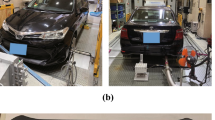Abstract
An advanced driver assistance system (ADAS) uses radar, visual information, and laser sensors to calculate variables representing driving conditions, such as time-to-collision (TTC) and time headway (THW), and to determine collision risk using empirically set thresholds. However, the empirically set threshold can generate differences in performance that are detected by the driver. It is appropriate to quickly relay collision risk to drivers whose response speed to dangerous situations is relatively slow and who drive defensively. However, for drivers whose response speed is relatively fast and who drive actively, it may be better not to provide a warning if they are aware of the collision risk in advance, because giving collision warnings too frequently can lower the reliability of the warnings and cause dissatisfaction in the driver, or promote disregard. To solve this problem, this study proposes a collision warning system (CWS) based on an individual driver’s driving behavior. In particular, a driver behavior model was created using an artificial neural network learning algorithm so that the collision risk could be determined according to the driving characteristics of the driver. Finally, the driver behavior model was learned using actual vehicle driving data and the applicability of the proposed CWS was verified through simulation.
Similar content being viewed by others
References
Ali, G., Alreza, K. and Maysam, F. (2014). Optimal fuzzy control system design for car-following behaviour based on the driver–vehicle unit online delays in a real traffic flow. Proc. Institution of Mechanical Engineers, Part D: J. Automobile Engineering 228, 12, 1440–1451.
Cao, M. S., Ding, Y. J., Ren, W. X., Wang, Q., Ragulskis, M. and Ding, Z. C. (2017). Hierarchical wavelet-aided neural intelligent identification of structural damage in noisy conditions. Applied Sciences 7, 4, 391–411.
Choi, J. W., Yi, K. S., Suh, J. Y. and Ko, B. C. (2014). Coordinated control of motor-driven power steering torque overlay and differential braking for emergency driving support. IEEE Trans. Vehicular Technology 63, 2, 566–579.
Fu, X., Li, S. and Jaithwa, I. (2015). Implement optimal vector control for LCL-filter-based grid-connected converters by using recurrent neural networks. IEEE Trans. Industrial Electronics 62, 7, 4443–4454.
Hummel, T., Kuhn, M., Bende, J. and Lang, A. (2015). Advanced driver assistance systems. German Insurance Association Insurers Accident Research 6, 1, 1–63.
Kim, H. J. (2016). Design and Evaluation of Alert Threshold for Takeover Request in Partial Autonomous Vehicles considering Human Factors. M. S. Thesis. Kookmin University. Seoul, Korea.
Kim, M. H. and Son, J. W. (2011). On-road assessment of in-vehicle driving workload for older drivers: Design guidelines for intelligent vehicle. Int. J. Automotive Technology 12, 2, 265–272.
Kim, M. H., Lee, S., Ha, K. N. and Lee, K. C. (2013). Implementation of a fuzzy-inference-based low-speed, close-range collision warning system for the urban area. Proc. Institution of Mechanical Engineers, Part D: J. Automobile Engineering 227, 2, 234–245.
Korean Road Traffic Authority (2016). Statistical Analysis of Traffic Accidents in the Local Government in 2015. Traffic Accident Analysis Center.
Lee, M. S. and Jeong, H. Y. (2014). Driver propensity characterization for different forward collision warning times. Int. J. Automotive Technology 15, 6, 927–936.
Lee, S. H., Lee, S., Lee, K. C. and Kim, M. H. (2017). Analytical hybrid redundancy system for the fault tolerance of advanced driver assistance systems. Proc. Institution of Mechanical Engineers, Part D: J. Automobile Engineering 231, 12, 1660–1665.
Martínez-morales, J. D., Palacios-hernández, E. R. and Velázquez-carrillo, G. A. (2015). Modeling engine fuel consumption and Nox with RBF neural network and mopso algorithm. Int. J. Automotive Technology 16, 6, 1041–1049.
Min, S. K. and Lee, K. S. (2003). Driver adaptive control algorithm for intelligent vehicle. Trans. Korean Society of Mechanical Engineers A 27, 7, 1146–1151.
National Highway Traffic Safety Administration (2015). Traffic Safety Facts 2014.
Vector (2010). CANoe. FlexRay 7.2 Product Catalog.
Wang, J., Wang, Q. N., Zeng, X. H., Wang, P. Y. and Wang, J. N. (2015). Driving cycle recognition neural network algorithm based on the sliding time window for hybrid electric vehicles. Int. J. Automotive Technology 16, 4, 685–695.
Wang, J., Zhang, L., Zhang, D. and Li, K. (2013). An adaptive longitudinal driving assistance system based on driver characteristics. IEEE Trans. Intelligent Transportation Systems 14, 1, 1–12.
Author information
Authors and Affiliations
Corresponding author
Rights and permissions
About this article
Cite this article
Lee, S.H., Lee, S. & Kim, M.H. Development of a Driving Behavior-Based Collision Warning System Using a Neural Network. Int.J Automot. Technol. 19, 837–844 (2018). https://doi.org/10.1007/s12239-018-0080-6
Received:
Revised:
Accepted:
Published:
Issue Date:
DOI: https://doi.org/10.1007/s12239-018-0080-6




